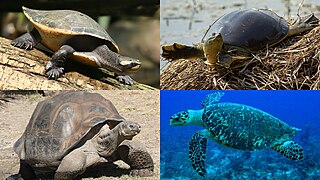
Turtles are reptiles of the order Testudines, characterized by a special shell developed mainly from their ribs. Modern turtles are divided into two major groups, the Pleurodira and Cryptodira, which differ in the way the head retracts. There are 360 living and recently extinct species of turtles, including land-dwelling tortoises and freshwater terrapins. They are found on most continents, some islands and, in the case of sea turtles, much of the ocean. Like other amniotes they breathe air and do not lay eggs underwater, although many species live in or around water.

The mata mata, mata-mata, or matamata is a freshwater turtle species found in South America, primarily in the Amazon and Orinoco basins. It is one of two extant species in the genus Chelus, the other being Chelus orinocensis.
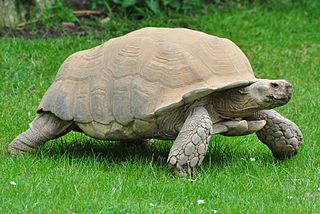
The African spurred tortoise, also called the sulcata tortoise, is an endangered species of tortoise inhabiting the southern edge of the Sahara Desert, the Sahel, in Africa. It is the largest mainland species of tortoise in the world, and the third-largest in the world, after the Galapagos tortoise and Aldabra giant tortoise. It is the only living species in its genus, Centrochelys, with the five other species in the family already extinct.

Pseudemys is a genus of large, herbivorous, freshwater turtles of the eastern United States and adjacent northeast Mexico. They are often referred to as cooters, which stems from kuta, the word for turtle in the Bambara and Malinké languages, brought to America by enslaved people from Africa.

The pig-nosed turtle, also known as the pitted-shelled turtle or Fly River turtle, is a species of turtle native to northern Australia and southern New Guinea. It is the only living member of the family Carettochelyidae, which are related to softshell turtles.

Chersobius signatus is the world's smallest species of tortoise. The species is commonly known as the speckled tortoise and also known locally as the speckled padloper and internationally as the speckled Cape tortoise. A member of the genus Chersobius, it is endemic to South Africa.

The Indian narrow-headed softshell turtle, also known as the small-headed softshell turtle or the Indo-Gangetic softshell turtle, is an endangered species of softshell turtle native to waterways and rivers of the Indian subcontinent. It is very large, feeding on fish, frogs, worms, crustaceans and molluscs, and even the occasional swimming small rodent or other mammal. C. indica, like other softshell turtles, uses it flexible shell to dig itself deep into sandy lake and river bottoms; here, it patiently waits for potential prey to swim by. They will also ambush and chase their prey, depending on availability, the time of year, and size of the prey. In the past it was included as a subspecies of Chitra chitra, a species restricted to Southeast Asia using current taxonomy.
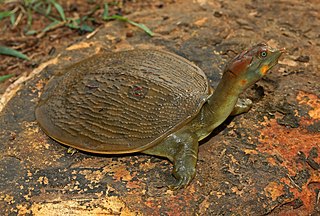
Leith's softshell turtle is a species of turtle in the family Trionychidae. The species is found in peninsular Indian rivers including the Thungabhadra, Ghataprabha, Bhavani, Godavari, Kaveri and Moyar Rivers. The type locality is Pune in India.
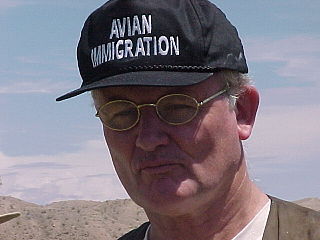
Peter Charles Howard Pritchard was a leading turtle zoologist. Pritchard was educated at Oxford University and the University of Florida, where he received a Ph.D. and specialized in Zoology. He was most commonly known for his career of almost 40 years for the conservation of turtles.

The Mary River turtle is an endangered short-necked turtle that is endemic to the Mary River in south-east Queensland, Australia. Although these turtles were known to inhabit the Mary River for nearly 30 years, it was not until 1994 that they were recognised as a new species. There has been a dramatic decrease in their population due to low reproduction rates and an increase of depredation on nests.

The Nubian flapshell turtle or Nubian soft-shelled turtle is one of two species of softshell turtle in the genus Cyclanorbis of the Trionychidae family. It is thought to have ranged from West Africa east through Central Africa to South Sudan, although it has been extirpated from the vast majority of its range.

The black spine-neck swamp turtle, also commonly known as the spiny-neck turtle or Spix's sideneck turtle, is a species of turtle in the family Chelidae. The species is endemic to South America, specially in the Southern Cone region.
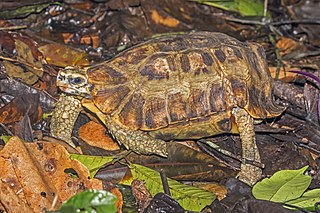
Home's hinge-back tortoise is a species of tortoise in the family Testudinidae. The species is endemic to Africa.
Pelusios broadleyi, commonly known as the Turkana mud turtle, Broadley's mud turtle, or the Lake Turkana hinged terrapin, is a species of turtle in the family Pelomedusidae. The species is native to eastern Africa.
The variable mud turtle, also known as Rhodesian mud turtle, Mashona hinged terrapin or variable hinged terrapin, is a species of turtle in the family Pelomedusidae. It is widely distributed in Central, East, and Southern Africa. The species was officially described by John Hewitt in 1927 and had to be broken into subspecies due to color variations on the heads of the turtles acrost the regions.

Eric V. Goode is an American entrepreneur, conservationist, and filmmaker. He is known as the creator of the art nightclub Area, the Bowery Hotel and the Waverly Inn. Goode is also known for being the founder of the Turtle Conservancy and for producing and directing Tiger King.
John L. Behler was an American naturalist, herpetologist, author, and activist known for his work in conserving endangered species of turtles, snakes, and other reptiles. He served as curator of herpetology at the Bronx Zoo, part of the Wildlife Conservation Society from 1976 to 2006. He co-chaired the IUCN Tortoise and Freshwater Turtle Specialist Group, and was a founding member of the Turtle Survival Alliance, which co-present the Behler Turtle Conservation Award with the Turtle Conservancy and Turtle Conservation Fund. The Behler Turtle Conservation Award is a major annual award to honor leadership in the field of freshwater turtle and tortoise conservation. The Turtle Conservancy named its captive breeding center, the Behler Chelonian Center, in his honor.

Adanson's mud turtle is a species of turtle in the family Pelomedusidae. The species is endemic to north-central Africa.
The Ivory Coast mud turtle is a species of turtle in the family Pelomedusidae. It is one of the most recently described turtle species.
The Pelusios cupulatta is typically found in riverine and wetland habitats mainly located in the southern Ivory Coast of West Africa. Endemic to the Upper Guinean forest region such as wetlands/rivers they are usually found primarily in forested banks as well as aquatic vegetation. Compared to other counterparts within its family, P. Cupulatta prefers an abundance of aquatic vegetation as its primary habitat. Despite this, Pelusios castaneus is a potential competitor due to similar habitats albeit different preferences regarding specific locations. Interspecific competition is able to regulate the coexistence of potential competitors but also niche expansion is available within the family when alone.
Comparative to other species at a local spatial level, Pelusios niger and Pelusios cupulatta both belong to larger size categories compared to others within the Pelusios records with the maximum male SCL being 31.3 and the maximum female SCL being 27.1. The two different turtle species are also allopatric, meaning that they are related but occur in separate non-overlapping geographical areas compared to the sympatric of P. castaneus. White P. castaneus intensely uses forested banks, P, and cupulatta aren't typically found in such areas as they aim for places with large amounts of aquatic vegetation. In presence of P. niger, P. cupulatta are usually found less than 10 km away showing how closely these two groups typically reside at roughly close locations.
Kalyar Platt is a Burmese herpetologist and turtle conservationist. She is the director of the Myanmar Program of the Turtle Survival Alliance and oversees conservation, breeding and reintroduction projects for some of Southeast Asia's rarest turtle species. She formerly worked for Wildlife Conservation Society and earned her PhD from Bangkok's Chulalongkorn University in 2007.















